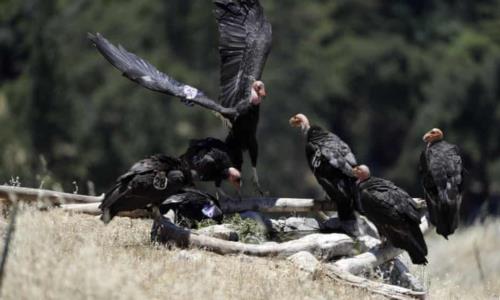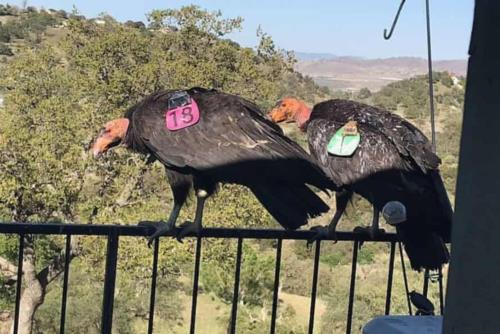#Al Thaer
Nearly extinct in the 1980s, an intensive programme to reverse the bird’s decline has made it a conservation success story

California condors at a watering hole in the Ventana Wilderness, California. The bird is making an impressive comeback from near extinction three decades ago. Photograph: Marcio José Sánchez/AP
Despite being the largest flying bird in North America, with a wingspan of up to three metres, you would have been hard pushed to see a California condor in the wild in the 1980s. In a last-ditch effort to save the birds, after decades of persecution and population collapse, the few remaining were captured in 1987 for a multimillion-dollar intensive conservation programme.
Today, there are more than 200 in the wild, and local people are already starting to notice. In May 2021, about 10% of the entire population of the birds in the Golden State decided to roost on a woman’s home in Tehachapi, southern California, damaging her decking with “concrete-like” excrement, an incident that went viral on Twitter when her daughter posted photos.
Amid the ominous warnings about the collapse of Earth’s web of life and the consequences for human civilisation, the California condor has become a powerful symbol of what conservation can achieve.
Several studies have shown that the continued decline of biodiversity around the world is not an inevitability. Alongside the California condor, the Iberian lynx, Przewalski’s horse and Puerto Rican amazon parrot are among 48 saved from extinction by conservationists.

California condors on Cinda Mickols’s porch railing in Tehachapi. Photograph: Cinda Mickols/AP
A new metric published by the International Union for Conservation of Nature (IUCN) last year, known as thre Green Status of Species, is helping scientists plot a path to recovery for threatened animals and plants, not just halt their extinction. It estimates the California condor, despite still being listed as critically endangered on the IUCN red list, has the potential for “a significant rebound over the next century” across its previous range from British Columbia to Baja California, giving hope to many more of the one million species threatened with extinction.
Extinction risk is a very absolute thing. Recovery, however, is relative
Molly Grace, researcher
“Extinction risk, which we’ve used to measure conservation progress for decades, is a very absolute thing. A species is either at risk of extinction or it’s not. Recovery, however, is relative,” says Molly Grace, a University of Oxford researcher who led the development of the IUCN’s green status tool. “Every species exists in different abundances and different distributions across the planet, so recovery has to be measured relatively.”
The pink pigeon, the burrowing bettong and Sumatran rhino were among the first 181 species to be assessed by 200 scientists from 171 institutions in the decade-long effort to develop the green status metric, which looked at historical population size, present-day distribution, the success of previous conservation efforts and viable habitat.
The path to recovery is precarious. For the California condor, lead poisoning from the accidental ingestion of bullets used by hunters remains a threat and is responsible for about 50% of all known causes of death of the birds. The heavy metal builds up in their bodies over time as they eat carrion, meaning they often do not survive, even if treated.
California became the first state to introduce a ban on lead ammunition to protect wildlife, in 2019, while in Arizona and Utah, where condors have been reintroduced around the Vermilion Cliffs, hunters purchasing big-game permits have been given $50 worth of lead-free ammunition to help protect the birds.

Adult male condor number 54 flying from the Navajo bridge over the Colorado River. The birds have a wingspan of up to three metres. Photograph: Lee Rentz/Alamy
Just as in South America, where the condor is an important Inca symbol alongside the puma and snake, America’s largest wild birds are sacred in California. In the north of the state, the Yurok people are working with the authorities to continue its recovery.
Joseph L James, chairman of the Yurok tribe, told the Guardian earlier this year: “Condor reintroduction is a real-life manifestation of our cultural commitment to restore and protect the planet for future generations.”
Find more age of extinction coverage here, and follow biodiversity reporters Phoebe Weston and Patrick Greenfield on Twitter for all the latest news and features
Source: The Guardian

